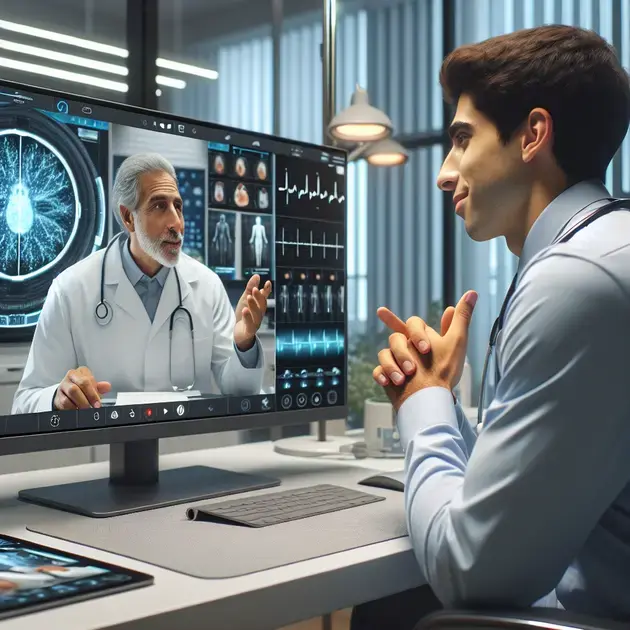Medical Professional: A Guide to the Healthcare Field
As a medical professional in today’s ever-evolving healthcare landscape, it is crucial to stay informed about the latest advancements and trends in the industry. From new treatments to medical technologies, staying up-to-date is essential for providing the best possible care to patients.
With the increasing focus on preventive care and the growing demand for healthcare services, medical professionals play a vital role in promoting overall wellness and disease prevention. It is important for medical professionals to continue their education and training to meet the changing needs of patients and the healthcare system.

The Importance of Continuous Education for Medical Professionals
Continuous education is crucial for medical professionals to stay updated with the latest advancements, research, and technologies in the healthcare industry. One effective way to ensure continuous education is by enrolling in online courses or webinars offered by reputable institutions. Websites such as Coursera and Udemy provide a wide range of courses in various medical fields, allowing professionals to learn at their own pace and convenience.
Another valuable method of continuous education is attending medical conferences and seminars. Platforms like Medscape and MedPage Today offer information on upcoming events where medical professionals can engage with experts, participate in workshops, and network with peers. These conferences often cover topics on recent medical breakthroughs, treatment methods, and best practices.
Medical journals and publications are also essential resources for continuous education. Subscribing to platforms like PubMed or JAMA Network allows professionals to access the latest research articles, case studies, and clinical trials. By regularly reading and reviewing these publications, medical professionals can expand their knowledge and stay informed about current trends in their field.
Collaborating with industry mentors and experts is another valuable aspect of continuous education. Platforms like Doximity and Figure 1 provide opportunities for medical professionals to connect with experienced practitioners, seek guidance on complex cases, and engage in discussions about emerging healthcare challenges. By seeking mentorship and guidance, professionals can enhance their skills and expertise.
Lastly, pursuing advanced certifications and specialized training programs can significantly contribute to continuous education for medical professionals. Websites such as the American Association of Physician Specialists and BoardVitals offer board certification review courses and resources to help professionals prepare for examinations and maintain their certification status.
The Role of Medical Professionals in Promoting Preventive Care
Medical professionals play a vital role in promoting preventive care and educating patients about the importance of maintaining their health and well-being. One of the key steps in promoting preventive care is conducting regular screenings and assessments to detect potential health issues at an early stage. Platforms like Healthfinder.gov provide guidelines on preventive services and screenings recommended for different age groups and risk factors.
Engaging in patient education and counseling is another crucial aspect of promoting preventive care as a medical professional. Websites like Healthwise and Health Education Resources offer educational materials and resources that professionals can use to inform patients about healthy lifestyle choices, disease prevention, and vaccination schedules. By encouraging patients to take an active role in their healthcare, professionals can help prevent future health complications.
Utilizing electronic health record (EHR) systems and patient portals can also enhance preventive care efforts. Platforms like Epic and Cerner provide tools for medical professionals to track patient data, send reminders for screenings and follow-ups, and monitor health indicators over time. By leveraging technology, professionals can streamline preventive care initiatives and improve patient outcomes.
Collaborating with other healthcare providers and community organizations is essential for promoting preventive care on a larger scale. Platforms like the Centers for Disease Control and Prevention (CDC) and the World Health Organization (WHO) offer resources and guidelines for professionals to participate in public health campaigns, disease prevention initiatives, and community outreach programs. By working together, medical professionals can create a more significant impact on improving overall health and well-being.
Continuing professional development in preventive care strategies is crucial for medical professionals to stay informed about the latest guidelines and recommendations. Platforms like the American Academy of Family Physicians and the American College of Preventive Medicine offer training programs, webinars, and resources to help professionals enhance their preventive care skills and knowledge.
Adapting to the Changing Healthcare Landscape as a Medical Professional
As the healthcare landscape continues to evolve, medical professionals must adapt to new technologies, policies, and patient care models to deliver quality healthcare services effectively. One way to adapt is by staying informed about healthcare reforms and regulatory changes. Websites like Health Affairs and the Healthcare Financial Management Association provide updates on policy developments, reimbursement models, and emerging trends in the industry.
Embracing telemedicine and virtual care solutions is another essential aspect of adapting to the changing healthcare landscape. Platforms like Teladoc and Amwell offer telehealth services that enable professionals to connect with patients remotely, provide consultations, and monitor chronic conditions. By incorporating telemedicine into their practice, professionals can improve access to care and enhance patient convenience.
Collaborating with interdisciplinary healthcare teams is crucial for adapting to the changing landscape and providing comprehensive patient care. Platforms like Doximity and Figure 1 allow professionals to connect with specialists, nurses, pharmacists, and other healthcare providers to coordinate care, share insights, and make informed decisions. By working collaboratively, professionals can address complex healthcare challenges more effectively.
Investing in professional development and training in areas such as data analytics and population health management is essential for professionals to thrive in the changing healthcare environment. Websites like the Healthcare Information and Management Systems Society (HIMSS) and the American Health Information Management Association (AHIMA) offer courses and certifications to help professionals develop skills in health informatics, data management, and quality improvement.
Lastly, maintaining a patient-centered approach and prioritizing patient engagement are key factors in adapting to the evolving healthcare landscape. Platforms like MyChart and PatientPoint provide tools for professionals to communicate with patients, involve them in treatment decisions, and promote health literacy. By focusing on patient needs and preferences, professionals can deliver more personalized and effective care in today’s dynamic healthcare setting.

Staying Updated on Medical Innovations as a Professional
As a healthcare professional, staying updated on medical innovations is crucial to providing the best care for your patients. With advancements happening rapidly in the field of medicine, it is essential to continuously educate yourself on the latest technologies, treatments, and research. By attending conferences, workshops, and seminars, you can stay abreast of the newest developments in your specialty and incorporate them into your practice.
One way to ensure you are always informed about medical innovations is to subscribe to reputable medical journals and publications. These sources often feature groundbreaking research studies and articles on emerging technologies that can significantly impact the way healthcare is delivered. Additionally, joining online forums and discussion groups related to your field can provide valuable insights and discussions on current trends and advancements.
Collaborating with colleagues and participating in multidisciplinary team meetings can also help you stay updated on medical innovations. By sharing knowledge and experiences with other healthcare professionals, you can gain new perspectives and learn about innovative approaches to patient care. Embracing a lifelong learning mindset and being open to change are essential attitudes for professionals who want to remain at the forefront of medical advancements.
Ultimately, by staying updated on medical innovations, you not only enhance the quality of care you provide to your patients but also contribute to the advancement of healthcare as a whole. Continuous education and awareness of emerging technologies are key to evolving as a healthcare professional and adapting to the ever-changing landscape of medicine.
The Impact of Telemedicine on Medical Practice
Telemedicine, the provision of healthcare services remotely through the use of telecommunication technologies, has revolutionized the way medical care is delivered. As the world becomes increasingly digital and interconnected, telemedicine offers numerous benefits for both healthcare providers and patients. One of the primary impacts of telemedicine on medical practice is improved access to care, especially for individuals in remote or underserved areas.
By leveraging telemedicine platforms, healthcare professionals can reach patients who may have limited access to traditional healthcare facilities, thereby reducing barriers to care. Additionally, telemedicine enhances convenience for patients by allowing them to consult with healthcare providers from the comfort of their homes, saving time and money on travel expenses. This increased accessibility can lead to earlier diagnosis and intervention, ultimately improving health outcomes.
Furthermore, telemedicine enables healthcare providers to collaborate more effectively and efficiently, leading to better coordination of care and improved patient outcomes. By leveraging real-time communication tools and secure electronic health records, multidisciplinary teams can consult and share information seamlessly, enhancing the quality of care provided to patients. The use of telemedicine also promotes patient engagement and empowerment, as individuals have greater control over their healthcare decisions and can access medical advice more readily.
Overall, the impact of telemedicine on medical practice is profound, revolutionizing the way healthcare is delivered and transforming the patient-provider relationship. By embracing telemedicine technologies, healthcare professionals can enhance access to care, improve patient outcomes, and drive innovation in the field of medicine.
Building Strong Patient Relationships in Healthcare
Building strong patient relationships is foundational to providing high-quality healthcare and fostering positive outcomes for patients. Developing a strong rapport with patients not only enhances their overall experience but also contributes to better treatment adherence and health outcomes. As a healthcare professional, it is essential to prioritize patient communication, empathy, and trust-building to establish and maintain strong patient relationships.
Effective communication is key to building strong patient relationships, as it fosters understanding, collaboration, and mutual respect. Listening attentively to patients’ concerns, preferences, and feedback demonstrates empathy and enhances the patient’s sense of being heard and valued. Clear and transparent communication about treatment plans, medications, and follow-up care is essential for building trust and empowering patients to actively participate in their health management.
Empathy is another critical component of building strong patient relationships, as it involves understanding and validating the emotional and psychological aspects of a patient’s experience. Showing empathy towards patients’ fears, anxieties, and challenges can help create a supportive and compassionate healthcare environment that promotes healing and well-being. Healthcare professionals who demonstrate empathy build trust and rapport with patients, leading to a more positive and collaborative care experience.
Establishing trust with patients is fundamental to building strong relationships in healthcare. Trust is earned through honesty, reliability, and consistency in care delivery. By being transparent about their expertise, limitations, and intentions, healthcare professionals can instill confidence in patients and foster a sense of security in their care. Trustworthy healthcare providers are more likely to engage patients in shared decision-making and empower them to take an active role in their health journey.
Conclusion
Staying updated on medical innovations is paramount for healthcare professionals striving to deliver top-notch care to their patients. With the rapid advancements in medicine, continuous education on the latest technologies and treatments is imperative. By actively engaging in conferences, workshops, and seminars, professionals can stay on top of emerging developments in their specialized fields and integrate them into their practice.
Subscribing to reputable medical journals and participating in online forums can ensure that professionals are always informed about groundbreaking research and emerging technologies that significantly impact healthcare delivery. Collaboration with colleagues and involvement in multidisciplinary team meetings offer valuable opportunities to exchange knowledge, gain fresh perspectives, and explore innovative approaches to patient care.
Ultimately, staying abreast of medical innovations not only elevates the quality of patient care but also contributes to the advancement of healthcare as a whole. Embracing a mindset of lifelong learning and openness to change are essential attributes for professionals aiming to remain at the forefront of medical advancements, evolve in their practices, and adapt to the dynamic landscape of medicine.